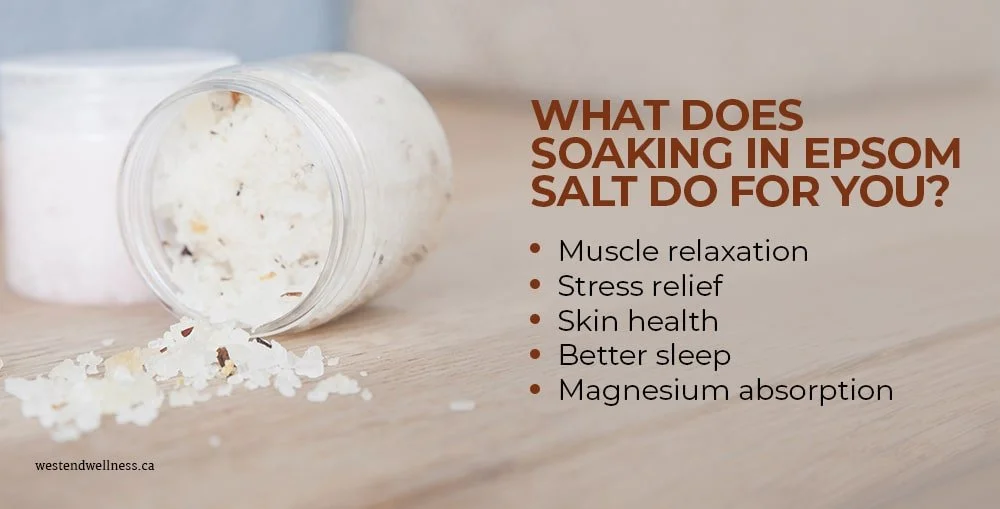Soak Away Your Troubles: The Magic of Epsom Salt Baths
Table of Contents Show
Quick Summary
Uncover the potential benefits of Epsom salt baths for relaxation, muscle soreness, and stress relief. This article examines the science behind Epsom salts, addresses common misconceptions, and provides practical tips for the perfect soak.
Discover when to use Epsom salts and when to avoid them, understand proper techniques for maximum benefit, and find answers to frequently asked questions. For both newcomers and long-time users, this overview will enhance your understanding and experience of Epsom salt baths.
Are you constantly battling sore muscles after your workouts?
Does stress from your demanding job leave you tossing and turning at night? Or perhaps you're simply feeling the aches and pains that come with age?
If any sound familiar, you might be surprised to learn that relief could be as simple as drawing a bath. But not just any bath – we're talking about an Epsom salt bath.
Epsom salt, despite its name, isn't like the salt you sprinkle on your food. It's a naturally occurring mineral compound of magnesium and sulphate that's been used for centuries to ease all sorts of bodily discomforts. From athletes to office workers, many swear by the soothing effects of an Epsom salt soak.
In this article, we'll break down what Epsom salts really are, how to prepare the perfect bath and the potential benefits you might experience.
We'll also examine what science has to say about these claims and discuss any precautions you should consider. Whether you're a longtime Epsom salt enthusiast or a curious newcomer, you'll find valuable information to help you decide if this age-old remedy is right for you.
So, please grab a cup of tea and settle in as we uncover the secrets behind this popular bathroom staple.
Who knows? Your next relaxing soak might be more beneficial than you ever imagined.
What's in the Box? Understanding Epsom Salts
Despite its name, Epsom salt isn't actually salt at all – at least not in the culinary sense. What you're getting in that box from the pharmacy is a compound called magnesium sulphate. It's a mineral that occurs naturally and has been used for centuries for its potential health benefits.
Magnesium sulphate consists of magnesium, sulphur, and oxygen. It gets its name from the town of Epsom in Surrey, England, where it was originally discovered in the spring waters. Unlike table salt (sodium chloride), Epsom salt has a bitter, unpalatable taste. That's why it's used for soaking rather than seasoning!
Many believe the magnesium in Epsom salts is the key to its potential benefits. Magnesium is an essential mineral that plays a role in over 300 biochemical reactions in your body.
From muscle function to energy production, magnesium is a crucial player in keeping your body running smoothly.
Dive Into Relaxation: Potential Benefits of Epsom Salt Bath
Now that we know what's in Epsom salts, let's talk about why people love using them. While scientific evidence is limited, many users report a range of benefits from their Epsom salt soaks:
-
Magnesium is known to promote relaxation. Many people find that an Epsom salt bath helps them unwind after a long day, potentially leading to improved sleep quality.
-
Athletes and fitness enthusiasts often turn to Epsom salt baths to soothe sore muscles. The warm water combined with the magnesium is thought to help relax tense muscles and reduce inflammation.
-
Some users report improvements in skin conditions like psoriasis or eczema after Epsom salt baths. The sulphates in Epsom salt may help with exfoliation, leaving skin feeling softer and smoother.
-
While it's debated how much magnesium is actually absorbed through the skin, some believe that Epsom salt baths can help boost magnesium levels in the body.
-
Although not scientifically proven, some people use Epsom salt baths as part of their detox routines, believing it helps draw toxins out of the body.
-
The magnesium in Epsom salts is thought to have anti-inflammatory properties, which could help with various aches and pains.
Science or Sorcery? What Research Says
You've heard the tales of Epsom salt's magical healing powers, but is there any truth to them? Let's dive into what the lab coats have to say about this popular bathroom staple.
Soothing the Skin
According to a comprehensive review in the Indian Journal of Dermatology, Epsom salt baths may help with certain skin conditions. The study notes that some users report improvements in skin conditions like psoriasis or eczema after Epsom salt baths. However, the authors caution that more research is needed to confirm these effects.
Easing Aches and Pains
The Arthritis Foundation suggests that warm baths, including those with Epsom salts, can help reduce joint tenderness and swelling. They explain, "When you warm up a sore joint or tired muscle, your blood vessels get bigger. This allows more blood, oxygen, and nutrients to be delivered to the injured tissues."
Stress-Busting Powers
Here's where things get interesting. A study published in MMW Fortschr Med found that people who took magnesium supplements daily showed improvements in their heart rate variability – a fancy way of saying their bodies got better at handling stress. While this study didn't look at Epsom salt baths specifically, it hints at magnesium's potential to help us chill out.
The Relaxation Factor
Even if the magnesium absorption is minimal, Epsom salt baths might still be beneficial due to the general relaxation effects of a warm bath. This relaxation effect could explain why so many people feel better after an Epsom salt soak.
Safety Considerations
While Epsom salt baths are generally safe for most people, it's important to note that ingesting Epsom salts can be dangerous. A case report in the Journal of Emergency Medicine described a patient who developed severe hypermagnesemia (too much magnesium in the blood) after ingesting Epsom salts. Always use Epsom salts as directed and avoid internal use unless specifically instructed by a healthcare provider.
The Verdict
While we can't say Epsom salt baths are a miracle cure, they're generally safe for most people when used as directed and might offer some benefits. At the very least, they're a great excuse to take a relaxing break from the daily grind.
Remember, more research is needed to fully understand how Epsom salts work their magic (or science). In the meantime, if you enjoy your Epsom salt baths and feel they help, there's no harm in continuing to use them as part of your self-care routine.
Dealing with tennis elbow can be troublesome, while Epsom salt can help; here we discuss how massage therapy, including sports massage, can effectively alleviate healing.
Caution: When to Skip the Soak
While Epsom salt baths are a popular remedy, they're not suitable for everyone or every situation. Understanding when to avoid these soaks is crucial for your safety and well-being.
Just as ingesting Epsom salts can be dangerous in some cases, using them improperly in baths can also lead to complications.
Let's explore some situations where you might want to skip the Epsom salt bath:
Open wounds or skin infections: If you have cuts, sores, or any open wounds, it's best to skip the Epsom salt bath. The salt can irritate these areas and potentially lead to infection.
Severe skin conditions: If you have severe eczema or psoriasis, consult your dermatologist before using Epsom salts. While some people find relief, others might experience irritation.
Pregnancy complications: If you're pregnant and have any complications, check with your healthcare provider before taking Epsom salt baths.
Recent surgery: If you've had recent surgery, especially on your skin, wait until you're fully healed before soaking in Epsom salts.
Allergies: Although rare, some people may be allergic to magnesium sulphate. If you experience any itching, rash, or discomfort, discontinue use immediately.
Remember, while Epsom salts can be beneficial for relaxation and potentially for joint pain, as suggested by the Arthritis Foundation, they're not a cure-all.
Always prioritize your health and consult with a healthcare professional if you have any concerns.
The Ritual: Preparing Your Perfect Epsom Salt Bath
Now that we've covered the safety aspects let's focus on how to make the most of your Epsom salt bath experience. Creating the right environment and following proper techniques can enhance the potential benefits of your soak.
Whether you're aiming to reduce joint pain or unwind after a long day, these steps will help you prepare the perfect Epsom salt bath:
Temperature matters: Aim for comfortably warm water, around 92-100°F (33-38°C). If it is too hot, you might risk dehydration or dizziness.
Measure it right: Use about 2 cups of Epsom salt for a standard-sized bathtub. If you have a larger tub, you might need a bit more.
Dissolve fully: Add the Epsom salts while the tub is filling. This helps them dissolve completely and distribute evenly.
Timing is key: Aim to soak for about 15-20 minutes. This duration allows for potential magnesium absorption without overdoing it.
Hydrate: Have a glass of water nearby. Warm baths can be dehydrating, so it's important to replenish fluids.
Post-bath care: After your soak, rinse off with cool water and pat your skin dry gently. Follow up with a moisturizer to lock in hydration.
Frequency: Start with once or twice a week and see how your body responds. Some people, like those with arthritis, might benefit from more frequent soaks, as suggested by the Arthritis Foundation study.
Mindfulness: Use this time to relax and de-stress. Remember, the German study we mentioned earlier found that magnesium supplementation could improve stress response, so combining your soak with some deep breathing or meditation might enhance the benefits.
By following these steps, you're setting yourself up for a safe and potentially beneficial Epsom salt bath experience. Just remember, while the warm bath itself is undoubtedly relaxing, more research is needed to prove all the claimed benefits of Epsom salts definitively.
Frequently Asked Questions About Epsom Salts
What does soaking in Epsom salt do for you?
Soaking in Epsom salt baths may offer several potential benefits:
Muscle relaxation: The magnesium in Epsom salts can help relax muscles and reduce inflammation, potentially easing soreness and pain.
Stress relief: Warm baths in general can reduce stress, and the magnesium in Epsom salts might enhance this effect by improving stress response.
Skin health: Some people report improvements in skin conditions like eczema or psoriasis after Epsom salt baths, although more research is needed to confirm these effects.
Better sleep: The relaxation induced by a warm Epsom salt bath may help improve sleep quality.
Magnesium absorption: While controversial, some believe that magnesium from Epsom salts can be absorbed through the skin, potentially addressing magnesium deficiency.
Remember, while many people report these benefits, scientific evidence is still limited, and more research is needed to confirm these effects conclusively.
How long should you sit in a bath with Epsom salt?
The optimal duration for an Epsom salt bath is typically 15-20 minutes. This timeframe allows for potential magnesium absorption and relaxation benefits without risking dehydration or skin irritation. Here's a breakdown:
Minimum time: 12 minutes
Ideal time: 15-20 minutes
Maximum time: 30 minutes
Avoid soaking for longer than 30 minutes, as prolonged exposure to warm water can lead to dehydration and may dry out your skin. If you're new to Epsom salt baths, start with shorter durations (around 10-12 minutes) and gradually increase the time as your body adjusts.
Always listen to your body and exit the bath if you feel lightheaded, uncomfortable, or overheated.
Do Epsom salts draw out toxins?
The claim that Epsom salts can "draw out toxins" is not supported by scientific evidence. While Epsom salt baths can be relaxing and may offer other benefits, they don't actively remove toxins from the body. Here's what you need to know:
No scientific proof: There's no research demonstrating that Epsom salts can extract toxins through the skin.
Body's natural detoxification: Your liver, kidneys, and digestive system are responsible for detoxifying your body, not your skin.
Sweating misconception: While you might sweat in a warm bath, sweat doesn't carry toxins out of your body.
Relaxation benefits: Epsom salt baths can help you relax, which may support your body's natural processes, including detoxification.
Skin benefits: Epsom salts may help exfoliate and soften the skin, which some people mistake for "detoxification."
While Epsom salt baths aren't a detox method, they can still be beneficial for a healthy lifestyle when used properly.
Should you rinse off after an Epsom salt bath?
Yes, it's generally recommended to rinse off after an Epsom salt bath. Here's why and how:
Remove residue: Rinsing helps remove any salt residue left on your skin, which could cause dryness or irritation if left on.
Cool down: A quick, cool rinse can help bring your body temperature back to normal after a warm bath.
How to rinse: Use lukewarm or cool water for a quick shower or rinse. Avoid using soap, as this might negate some of the moisturizing benefits of the bath.
Pat dry: After rinsing, gently pat your skin dry with a soft towel. Don't rub vigorously, as this can irritate your skin.
Moisturize: Apply a moisturizer while your skin is still slightly damp to lock in hydration.
Hydrate: Drink a glass of water after your bath to replenish any fluids lost through sweating.
By following these steps, you can maximize the potential benefits of your Epsom salt bath while minimizing any risk of skin irritation or dryness.
Soak It All In Your Epsom Salt Journey Awaits
We've journeyed through the world of Epsom salt baths, from their long-standing reputation as a home remedy to the scientific scrutiny they face today.
Whether you're a stressed-out professional, a weekend warrior nursing sore muscles, or someone simply looking to enhance their self-care routine, Epsom salt baths offer an accessible and potentially beneficial option.
Let's recap what we've learned:
Epsom salts might help soothe skin conditions and ease muscle soreness, though more research is needed to confirm these benefits.
The magnesium in Epsom salts could potentially help with stress reduction, as suggested by some studies.
While generally safe, there are situations in which Epsom salt baths should be avoided, such as when one has open wounds or certain health conditions.
Proper preparation and technique can enhance your Epsom salt bath experience and its potential benefits.
Everyone's body is different, and what works for one person may not work for another. If you're curious about trying Epsom salt baths, start with a short soak and see how your body responds.
Always listen to your body and consult a healthcare professional with any concerns.
Whether you're drawn to Epsom salt baths for their potential health benefits or simply for the relaxation they offer, there's no denying the power of taking time for yourself.
In our fast-paced world, the simple act of soaking in a warm bath can be a powerful form of self-care.
So why not give it a try?
Draw that bath, sprinkle in some Epsom salts, and take a moment to relax and rejuvenate. Your body (and mind) might thank you for it.
Ready to start your Epsom salt journey?
Remember to check with your healthcare provider if you have any health concerns, and always use Epsom salts as directed. Happy soaking!
If you have any further doubts or questions regarding this subject or another treatment, contact one of our experienced Acupuncturists or Registered Massage Therapists here at West End Wellness Clinic. You can either give us a call or make an appointment.
Disclaimer: Please remember this article is for informational purposes only and should not replace professional medical advice. Please consult a healthcare provider or someone with the correct qualifications before starting any new exercise or treatment program.





